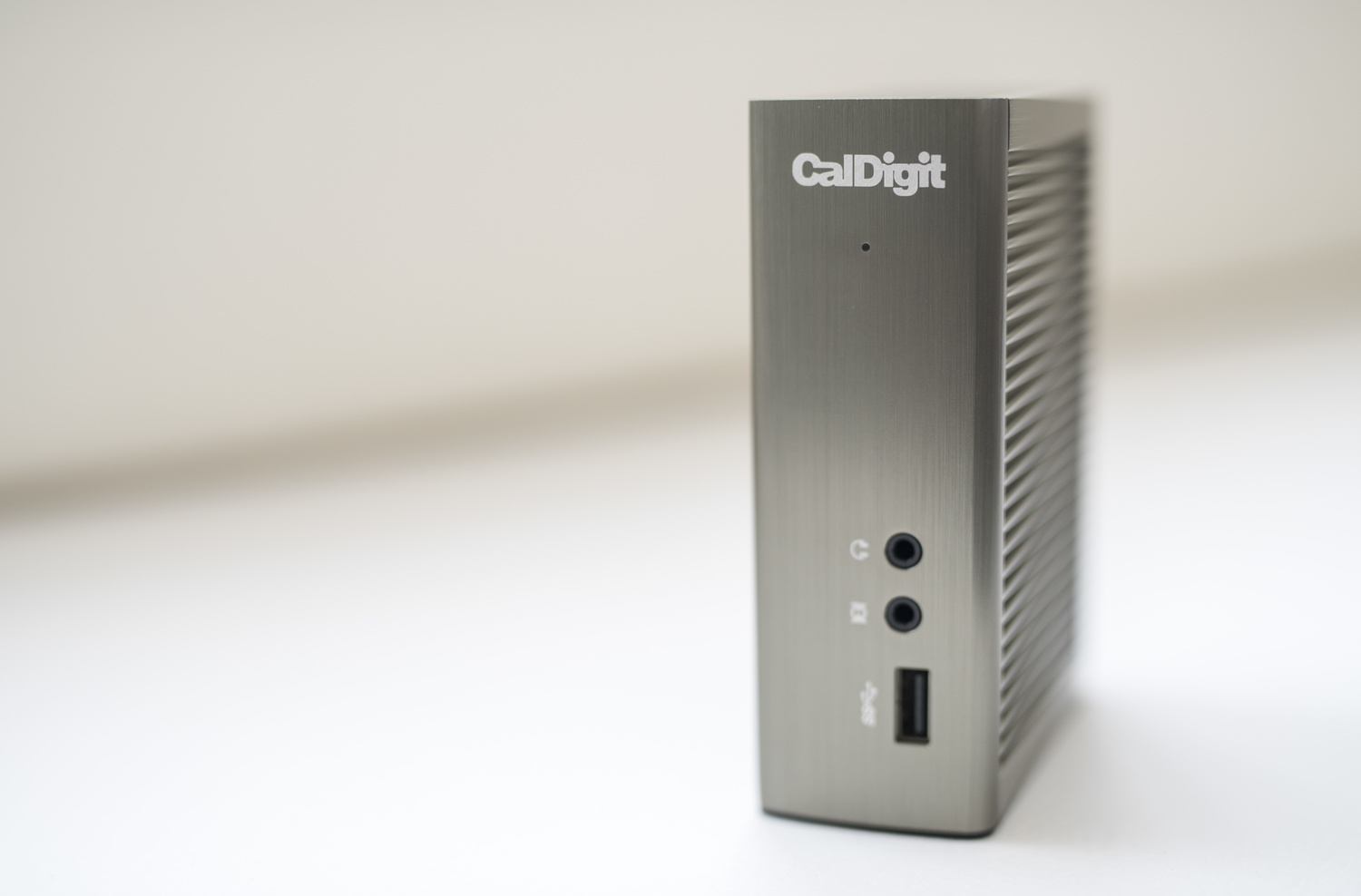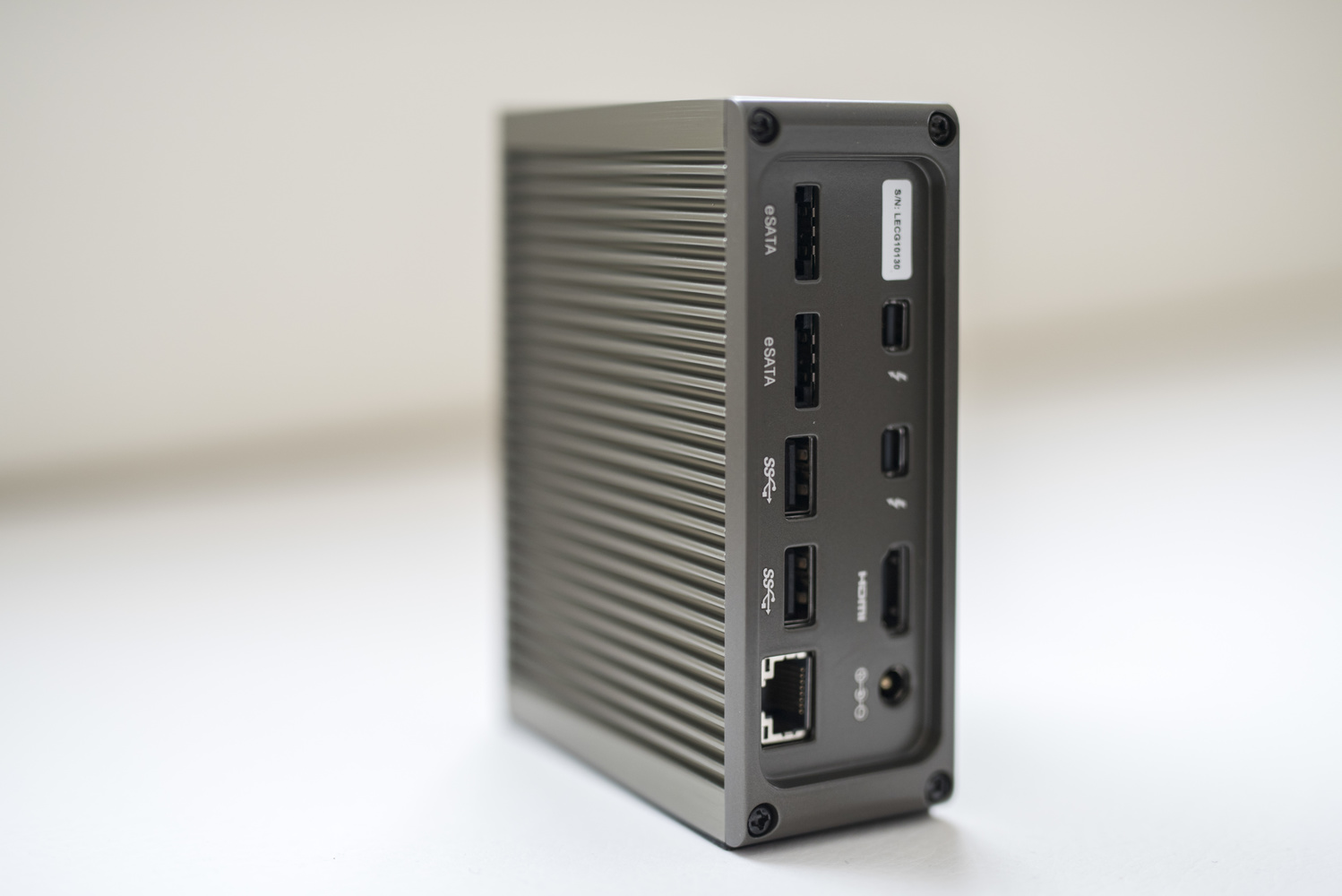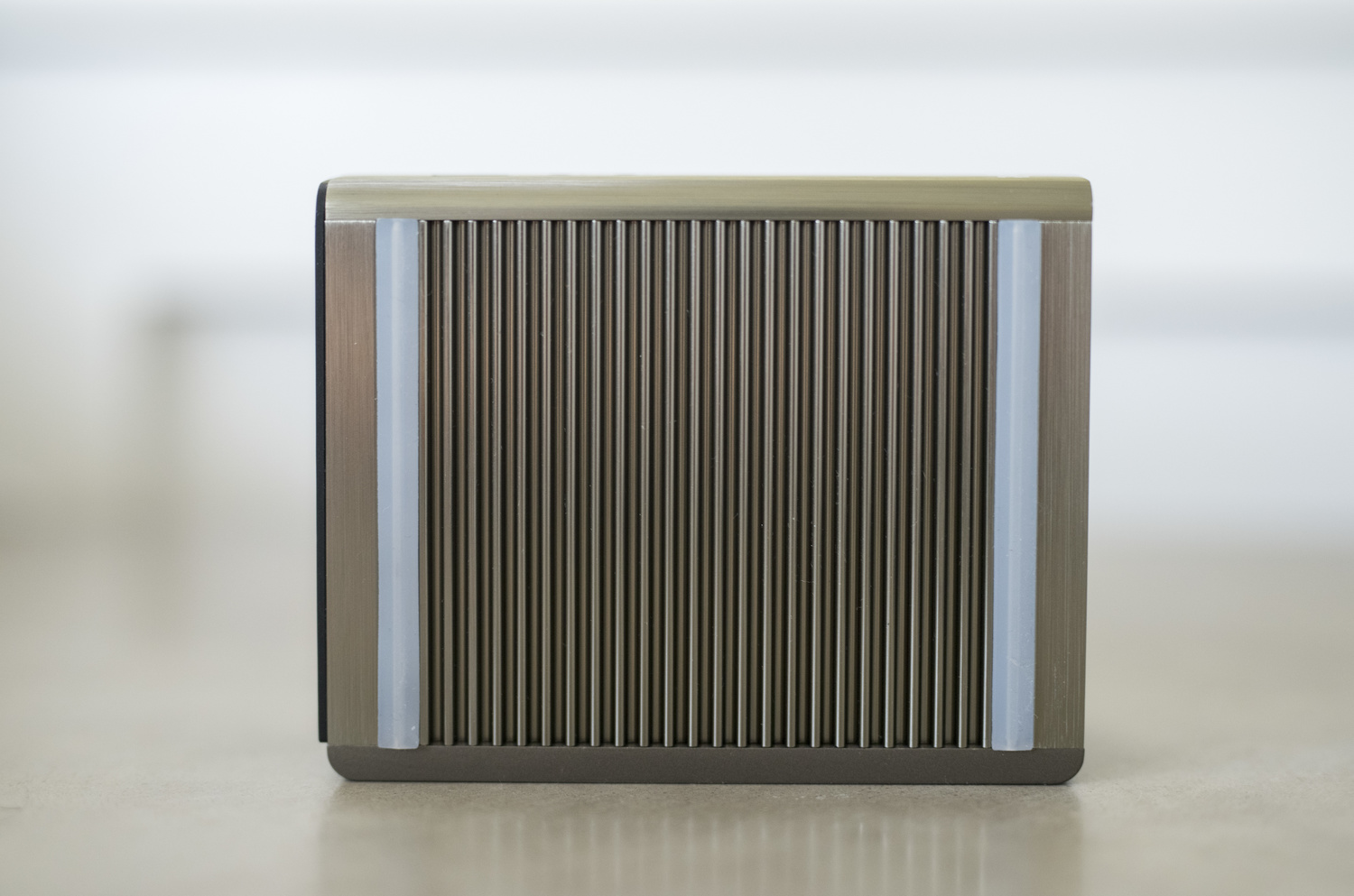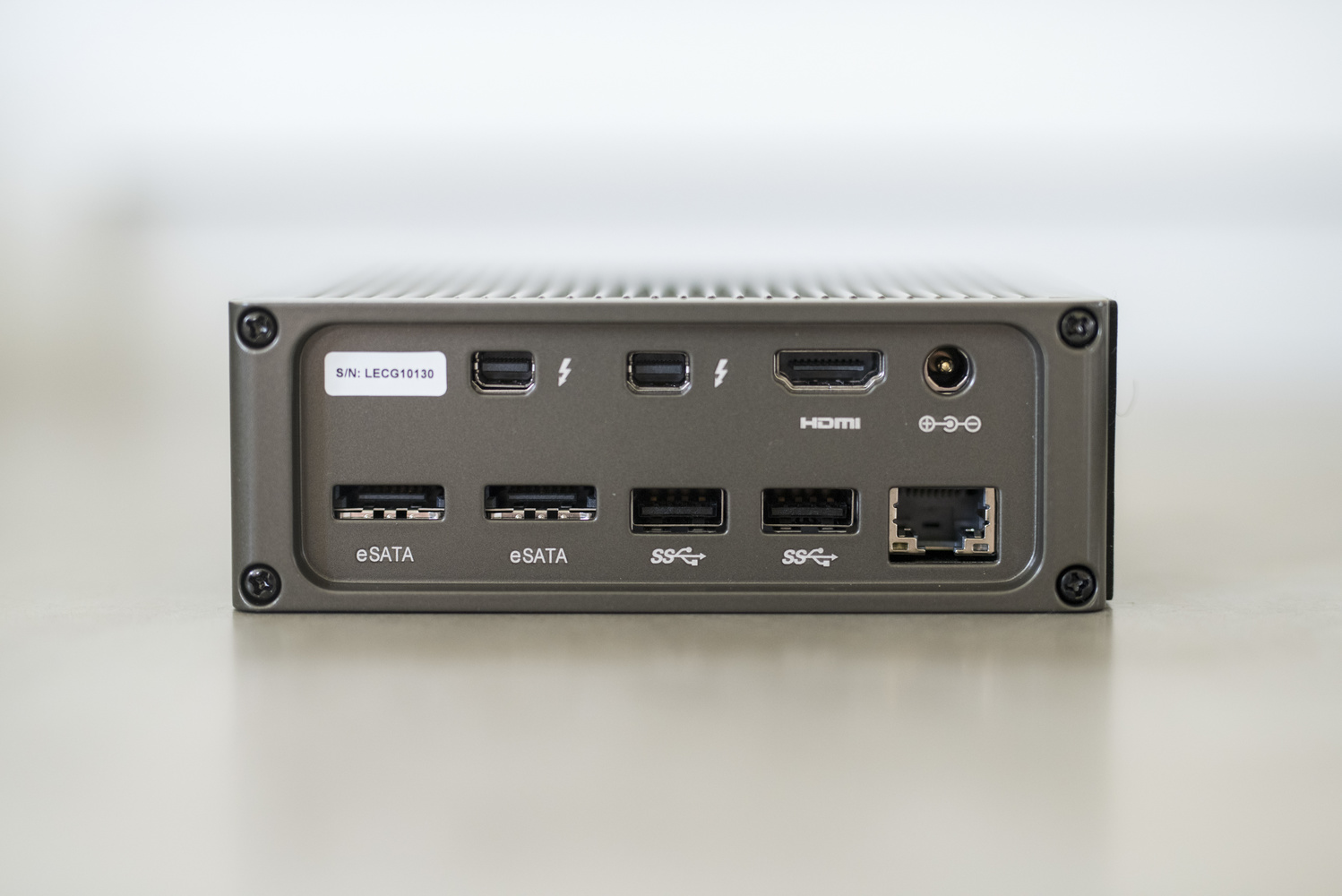Thunderbolt docks have always been something that I've wanted, but haven't absolutely needed. The $300-$500 price range of these little all-in-one boxes didn't spark urgency in my search for the perfect dock either. Given a little time for the excitement (and price) of Thunderbolt-related technology to die down a bit, however, the prospect began to grow more interesting. An improvement on their previous dock, CalDigit's $200 TS2 seemed to be the perfect connection dreambox at the right price. So how did reality fare against expectations?
A quick note before we begin for those interested in saving time: I'm trying something new... If you want all the most important information, feel free to scroll through the images and just read the captions. Everything you really need to know can be found there, and the rest is simply more detailed for those interested in more specifics. Please comment with your opinions on this format below if you don't mind! Thanks!
The first thing I noticed about the TS2 was that it was much smaller than I had anticipated. I thought the small, all-metal box would be the size of a rather large desktop drive -- something akin to a slightly more slender version of Western Digital's "Duo" drives is what I had in mind. However, to my pleasant surprise, the TS2 is about the size of a thick, but small, bible (enough with the smartphone size references, right?).
CalDigit boasts that this dock can be horizontally or vertically situated for a smaller footprint, unlike its sleek but less practical rivals like the $300 Belkin Thunderbolt Dock HD, which features almost the exact same functionality for a 50% increase in price over the TS2. Even so, the TS2 isn't something I have to stand up vertically for it to make sense on my desk. In fact, it's so small that it almost bothers me to have it directly on my desk at all...I just want to stack it on top of something to get the most out of every square inch.

The TS2 has a simple front interface with 1/8" headphone and input jacks along with an always-on, powered USB 3.0 port so you can charge your devices even when the unit is disconnected from the computer.
Thankfully, as with all of the Thunderbolt docks worth mentioning, each of the three USB ports on the TS2 are USB 3.0. It's nice that CalDigit didn't bother giving us a headache while saving itself just a few bucks for a couple USB 2.0 ports. The front, always-on USB port allows charging of your device even while it's unplugged from the computer. While it bugged me at first that all of the ports weren't this way, I was later thankful when I realized my external DVD writer (plugged into a rear port) would have always been running and humming if this were not the case.
Finally, separate 1/8" headphone output and 1/8" input jacks conveniently face the front as well so Dani Diamond won't have a problem should he want to switch to headphones some day to avoid bugging his neighbors with that abnoxious music. And of course, a small blue light (sorry, not pictured while "on") turns on when the device has power and is connected to the computer.

The rear ports include dual Thunderbolt 2.0 ports, an HDMI port for display connection, a power port for the unit itself, dual eSATA ports, dual USB 3.0 ports, and a gigabit ethernet jack for hard-line internet connectivity.
Rear ports are plentiful: Two Thunderbolt 2.0 ports, two USB 3.0 ports (for a total of three including the front port), a gigabit ethernet LAN connection, the welcome addition of a 4K-capable HDMI-out port, and a nice surprise of two ultra-fast, 6G eSATA ports. The Thunderbolt 2.0 ports, along with the triple USB 3.0 inputs, were expected. However, the addition of an HDMI-out for you 4k HDMI monitor lovers is nice. I will add that while eSATA isn't the most popular, it is just about the most direct connection you can make to an external hard drive. So, those without Thunderbolt capability will still be able to get just about every last ounce of speed out of their drives. And finally, a gigabity ethernet connection might seem odd to some, but with fewer computers (i.e. Apple laptops) including them for space-saving reasons, it's never a bad thing to have the most reliable connection possible for streaming, downloading, or uploading content. Those of us with Crashplan running 24/7 will surely be grateful.

Standing the TS2 upright puts the larger ethernet and likely always-in AC plug at the bottom level, where it naturally makes sense.

I always keep my place at room temperature, but I haven't felt the TS2 get even warm to the touch yet. I haven't quite put it through its paces with monitors and multiple Thunderbolt chains going in yet, but I think the all-aluminum heat sink design does an excellent job given that the unit doesn't have a fan. Silence sure is sweet.
The all-aluminum heat sink design keeps the unit cool to the touch even without an internal fan. The TS2 could definitely be pushed harder, but it likely will stay just as cool. The color itself is unassuming enough, though the marketing language that calls the "titanium" color similar or inspired by the design of the Mac Pro doesn't quite make sense -- it's not really similar. Still, the finish and feel is nice enough to make it somewhat unclear as to why this point was even discussed.

A nice touch included in the packaging are two silicone "feet" that fit perfectly (but very snuggly...be sure to press hard and even out) around the natural heat sink design for those placing the unit horizontally. No matter what the orientation the unit is in, however, it's light enough to need an extra hand the few times you may be plugging something into the unit.
A final pro on one small factor leads me to the only con, though this may be a bit picky... I have a personal pet peeve with quite an assortment of Thunderbolt accessories (hard drives, adapters, etc.) that place the Thunderbolt connection upside-down. CalDigit, thankfully, found some magical way to place them right-side up. This way, when you plug in your cable, the top side (with the Thunderbolt logo) is facing up, as one would expect. Unfortunately, something still has to be upside-down: the rear USB 3.0 ports. I'm sure manufacturers are limited by the orientations of the components that are made available for these devices, but must every device feature at least one upside-down connection? This doesn't matter at all in practice, however, because the rear ports specifically will likely be plugged in once and left alone.

You'll notice the protruding part of a female USB port is toward the top of the inside of the input jack, but not on the TS2. It's a silly thing to worry about, but considering the Thunderbolt 2.0 ports are the correct orientation, CalDigit made the right trade-off. Just to be clear, this doesn't seem to be a design or manufacturing error. Orientations on ports such as these is actually quite common for third-party devices such as docks and hard drives and is determined more often by necessary placement to keep the external design in tact than by a lack of forethought or manufacturing defect. All things considered, this gripe is so very minor.
There's still a reason I bought this dock: it's the best you can get for $200 ($235 with a 1-meter Thunderbolt cable).
For $200, the reality is that the CalDigit TS2 is probably the best Thunderbolt dock for the money -- it's why I bought one. A two-year warranty sweetens the pot considering the competition offers only one, but you still need a Thunderbolt cable (which CalDigit will include for an additional $35, which is a bit steep, but average).








I pre-ordered this and it works amazing. It was the final part that I needed for my desk. I have a MacBook Pro and a 27" Apple Cinema Display. I have a ton of USB devices, speakers, hard drives etc that all need to connect to my MBP. Now I connect the power and the single Thunderbolt cable and EVERYTHING is connected. It takes maybe 2 seconds. Apple finally got their shit together now and when you connect an external monitor, audio device etc, it remembers them and your preferences. So my monitor uses my preferred settings every time, the speakers take over automatically, the HDDs all mount, and the LAN connection overrides the WiFi so I can backup to the server!
Yup! Also, for those interested, there was no measurable difference in HDD write speeds whatsoever. I tried every possible scenario from simply copying folders of both small and large files to using BlackMagic disk tests. It's pointless to take a screen capture, but everything ran the same through my RAID 5 Promise Pegasus R4 with 4 7200RPM enterprise-class drives. So this doesn't slow anything down in case you had worries about that...
I know this article is from last February, but I am in the market for a good dock. Are you still a fan of this dock? Have any new issue cropped up? Have you used dual monitors with it? Would I be able to use a switch box with this dock?
I have my work MacbookPro, and work from home often. I use an Apple 27 inch monitor and would love to be able to also use my 20 inch LG as a second monitor. I also have my Mac Mini which of course needs a monitor and is using said LG monitor. I would love to be able to switch between the two, use the same keyboard, mouse and monitor setup. I really need to simplify my setup which is driving me crazy right now.
I am a designer, so I am on my computer(s) all week long.
Also, what is the need to purchase the additional $35 Thunderbolt cable? Just curious since the Thunderbolt monitor comes with cable. What would I use it for?
I think I have answered my own question with the extra cable, but still want to hear what you say.
Hi. Okay....so...a couple comments/suggestions based on what your asking (and yet, I'll still fall short on some answers for lack personal of experience in those cases).
I do not have dual monitors because I just don't need that. If I really want a second screen for managing iTunes or some kind of media to the side while I edit, I just open my MacBook Pro when it's plugged in, and voila! But in your case, I think you would be fine. You have several options -- all of which may work, but only one of which will NEED to work, and which will work... You can plug your second monitor into the dock and hope your computer can support it that way through one thunderbolt port... Or -- this one is more likely to work -- just use your second thunderbolt port on your mac for you second monitor. I'm also not sure about HDMI vs Thunderbolt in a dual-monitor setup (i.e. can both be used alongside one another?), but I'm sure there's plenty of info about that online.
As far as an extra thunderbolt cable...well...you just have to know how many you need for your setup. If you're going to have every thunderbolt port on your mac and your dock used up for various devices...that's 3 thunderbolt cables (one to the dock from some device, one between the dock and your device, and one between some other device and your computer's extra TB port that's still open). Want to daisy-chain devices? Just add more cables...etc. So that'll depend on what you plan to plug in in terms of hard drives, etc...
Finally, I still really like this dock and have had zero issues. Some other docks have come out since (actually, I think just the OWC one is "new"), but those are either bigger/similar/etc... The OWC one does offer more USB 3.0 ports, which is actually really nice. But it is bigger. So you know...as with anything...it's a trade-off. But some may not care about space on their desk, or they might wall-mount it or put it under their desks, etc...
All of these issues/considerations would be the same for any Thunderbolt dock on the market right now as far as I know. In fact, many of them seem to even source their materials/parts from similar suppliers (the similarity in some of the port layouts is just too close not to assume this). So there you go. Switch box? It should work....but again, if not for some reason, you could just hook it up to the extra TB port on your MacBook Pro instead of directly through the dock.
Hope that all helps!
Thank you for your reply. I was using briefly, a StarTech adapter for dual monitors. It would work only some of the time and seemed to crash the system often. I am hoping that I can just get an HDMI adapter for the LG monitor and use that while keeping the extra Thunderbolt port open for use on this dock. Unfortunately, a non Apple Monitor with a thunderbolt adapter will not daisy chain onto my Apple monitor. Need to win the lotto to afford another apple display to daisy chain that way.
Hope to get a dock shortly, so I will know soon enough.
Thanks again.
Well...to that end, you could do thunderbolt between you apple monitor and your laptop, as usual. Then thunderbolt another display directly from your laptop's other TB port. Then connect the dock to the apple display's port on the back. That way, a display isn't being daisy-chained, but you still have your docked setup. You could even switch the position of the dock and the apple monitor. Either way, you're not daisy-chaining the displays themselves..you're just daisy-chaining "beyond" your thunderbolt display to other devices...